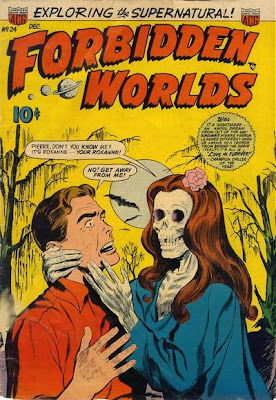 Detective Comics #393 (On Sale: September 30, 1969) has just a really ineffective cover by Irv Novick. The Batman figure seems squeezed in under the massive logo and it is hard to tell exactly how old Novick thinks Robin is. Ugh, I just don't like this one.
Detective Comics #393 (On Sale: September 30, 1969) has just a really ineffective cover by Irv Novick. The Batman figure seems squeezed in under the massive logo and it is hard to tell exactly how old Novick thinks Robin is. Ugh, I just don't like this one."The Combo Caper" is by Frank Robbins, Bob Brown and Joe Giella and although the cover scene does sort of happen in this issue, it is basically the last panel, so in that way this cover is sort of a cheap "come on." as the captioned question, "Why?," is never addressed. We begin with Batman and Robin noticing while on patrol a light on at the Winslow mansion. They knew very well that the Winslows are vacationing at their beach front estate next to Bruce's in Ocean Point so they enter and surprise an thief in mid caper. Before the thief escapes in the Batmobile no less, Robin lands a right jab to his covered face. The thief didn't have enough time to crack the Winslow's safe, but left behind a clue, an aluminum pop-top with the two sets of safe combinations scratched into its surface, the Winslow's and one other.
The next morning, after retrieving the abandoned Batmobile, Bruce, Dick and Alfred head out for Ocean Point for a little R & R. On the way they pick up Skeet Callum, an under-privileged teen in crisis that Bruce is attempting to mentor for the Civic Conscience Council. Skeet has an attitude the rub Dick the wrong way, and he also has a shiner and an addiction to Kool-Up soda, in the aluminum pop-top cans.
Once at the beach, Dick and Skeet run into Deena Winslow, who is also sporting a shiner and a Kool-Up addiction. That night Bruce, Dick and Skeet attend a big bash at the Winslow estate where they are introduced to world-traveler and yacht-owner Aristide Naxos. The teens all head out for a party on the beach where Skeet and Deena have an argument and Skeet takes off alone.
As the night wears on, Aristide makes his exit to his yacht and Mrs. Winslow tries to hit on Bruce, resulting in Bruce going upstairs to fetch her wrap, only to discover that the Winslow's safe here has been robbed. Looking around Bruce finds another pop-top with this safe's combination. Bruce remembers that Skeet is always drinking Kool-Up and tells him that if he robbed the place he can still give the jewels back, no questions asked. Skeet runs off and later Bruce laments that he may have pushed Skeet towards crime by accusing him. This sends Dick out to find him, which he does lying unconscious on the beach. Skeet says that he found Deena digging in the sand and that she was being signaled from Naxos's yacht and when he tried to ask her what was going on she decked him with her surfboard.
Later Dick rides out on a surfboard toward the yacht, gathering the attention of the guards on board. What they don;t see is Batman tagging along with the board underwater. using a rebreather. While Dick catches a few waves at night, Batman sneaks on to the yacht where he confronts Naxos and Deena. When Naxos pulls a gun Deena disarms him. Inside her can of Kool-Up are the jewels, which she stole to punish her parents for only buying her things instead of loving her. Later Skeet finds out that Batman came to his aid and that if Batman thinks he is worth something, then maybe he should too.
The final panel is a close-up of Batman thinking, "The case is over...the team-up is finished! This is good-bye for Batman and Robin!"
The Batgirl back-up is "Downfall of a Goliath!" by Frank Robbins, Gil Kane and Murphy Anderson. Reprinted in Showcase Presents: Batgirl Vol. 1 TPB.
Edited by Julius Schwartz.





































